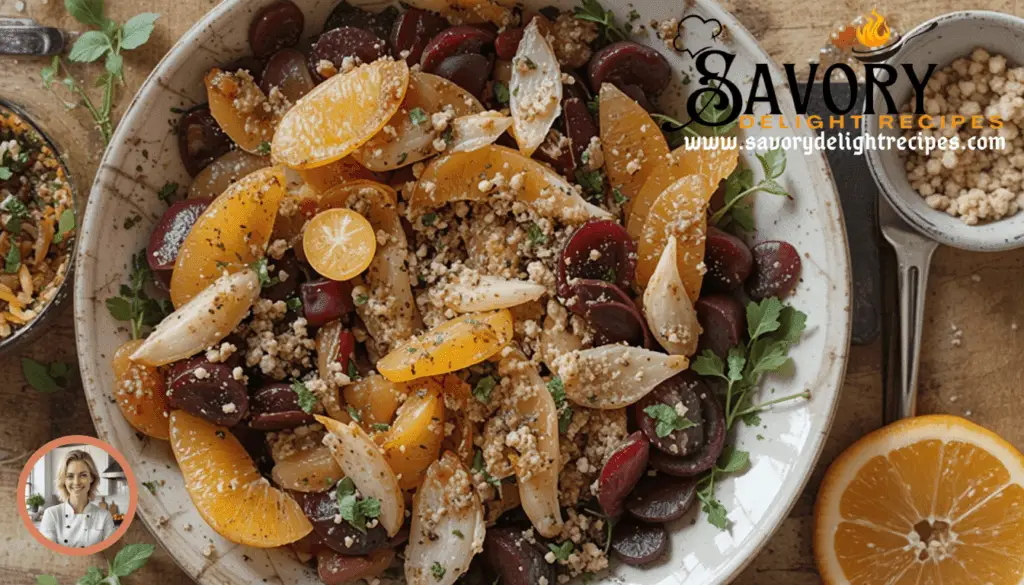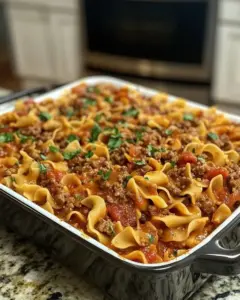Last Updated on 09/06/2025 by SAVORY DELIGHT RECIPES LLC
A salad that turns heads at dinner parties? The most stunning salads come from simple ingredients.
Sweet roasted beets, bright citrus, and creamy goat cheese blend together in a beautiful beet and orange salad. This classic combination has appeared on high-end restaurant menus for decades. You can now make it at home with ease.
This piece guides you through every step to create this beautiful dish. You’ll learn about roasting beets and the citrus supreme technique. The process includes selecting fresh ingredients and becoming skilled at professional plating techniques. Your roasted beet and orange salad will match any restaurant’s version.
Ready to create your own masterpiece? Let’s tuck into this foolproof guide that will help you nail this recipe every time.
Essential Ingredients and Equipment
The right ingredients and tools are the foundations of a great beet and orange salad with goat cheese. Let’s explore what you need to know about selecting and preparing your ingredients.
Choosing the Perfect Beets
Medium-sized beets about 2 to 3 inches in diameter will give you the best results. The perfect beets should feel firm with smooth, unblemished skin and an attached taproot. Smaller beets pack more sweetness and tenderness, while larger ones tend to develop tough, woody centers.
Beets with attached greens are a sign of freshness – just trim them off before you store them. Many grocery stores now make life easier by offering pre-cooked, vacuum-sealed beets in their produce section.
Selecting Quality Citrus and Cheese
The best oranges feel heavy for their size and show vibrant color. A ripe orange has a thin, bright skin that gives off a fresh, aromatic smell. The fruit should feel firm but yield slightly to pressure, which shows it’s ready to eat.
The goat cheese should be a ripened variety with a rind and creamy center that becomes soft when heated. Some excellent choices include:
- Crottin de Chavignol
- Chabichou du Poitou
- Fresh goat cheese logs
Required Kitchen Tools
Your roasted beet and orange salad with goat cheese needs these tools:
- Sharp knife to cut precisely
- Mandolin (optional) to slice beets uniformly
- Disposable food-prep gloves
- Dishwasher-safe cutting board or parchment paper
- Foil to roast beets
- Large baking pan
- Blender to prepare dressing
Note that beets can stain your hands, so gloves are essential. A protected work surface will keep your countertops clean. Proper storage helps – beets stay fresh up to a month in your refrigerator.
Mastering Beet Roasting Techniques
You can become skilled at roasting beets by understanding the techniques that bring out their natural sweetness. The right preparation and cooking methods will help your beet and orange salad reach restaurant-quality results.
Proper Cleaning and Preparation
Scrub your beets really well under cool running water to remove dirt. Many recipes suggest peeling beets before roasting, but keeping the skin on helps retain moisture and nutrients during cooking. The skin slides off easily after roasting, which makes the process much cleaner.
To prepare for roasting:
- Trim the leafy tops, leaving about 1-2 inches of stem
- Cut off the skinny tail end
- Place each beet on a piece of aluminum foil
- Drizzle with olive oil
- Wrap individually in foil
Temperature and Timing Guide
Your beets will roast best at temperatures between 375°F to 425°F. The cooking time depends on beet size:
| Beet Size | Temperature | Cooking Time |
|---|---|---|
| Small (golf ball) | 375°F | 30-40 minutes |
| Medium (tennis ball) | 375°F | 45-60 minutes |
| Large (softball) | 375°F | 60-75 minutes |
Place wrapped beets on a rimmed baking sheet to catch any drips. You should flip the beets every 30 minutes to ensure they cook evenly.
Testing for Doneness
You have several reliable ways to check if your beets are properly roasted. The quickest way is using a wooden skewer or fork to test tenderness. The skewer should glide smoothly through the thickest part of the beet with minimal resistance.
Different-sized beets might finish cooking at different times. Test each beet and remove it from the oven as it becomes tender. Let the beets cool for 5-10 minutes while still wrapped in foil. This residual heat helps loosen the skins, making them easier to remove for your beet and orange salad with goat cheese.
Citrus Preparation Methods
The right citrus preparation can lift your beet and orange salad with goat cheese from good to exceptional. These techniques will help you create restaurant-quality results every time.
Supreme Cutting Technique
You can create elegant, membrane-free citrus segments that add visual appeal and better texture to your salad with the supreme cutting method. Here’s how to do it:
- Cut off both ends of the orange until you see the flesh
- Stand the orange on one flat end
- Follow the fruit’s curve to slice away the peel and white pith
- Cut along each segment’s membrane lines
- Remove each segment gently
Pro tip: Keep a bowl underneath while you work to catch the juice – it’s perfect for your dressing.
Zesting Tips for Maximum Flavor
The peel holds amazing flavor potential through proper zesting. Your tool choice affects the zest’s texture and use:
| Tool | Best For | Result |
|---|---|---|
| Microplane | Dressings, marinades | Fine, delicate zest |
| Grater | Salads, heartier dishes | Course, textured zest |
| Knife/Stripper | Garnishes | Decorative strips |
Important: Stick to the colored portion of the peel – the white pith underneath tastes bitter.
Juice Extraction Secrets
Fresh citrus juice brings brightness to your beet and orange salad dressing. Here’s how to get more juice:
- Zest first, then juice
- Roll the fruit on your counter before cutting
- Let oranges reach room temperature for better yield
- Keep juice from supreme cutting process
Storage tip: You can keep fresh-squeezed juice in an airtight container for up to two weeks in your refrigerator. All the same, your roasted beet and orange salad with goat cheese tastes best with juice used within three days.
You can save the remaining pulp or freeze it in ice cube trays to use later in smoothies or broths.
Creating the Perfect Dressing
A perfect dressing brings your beet and orange salad with goat cheese together and creates a beautiful blend of flavors. A well-crafted vinaigrette will boost the earthiness of the beets and pairs perfectly with the creamy goat cheese.
Balancing Flavors
The success of your vinaigrette depends on getting the ratios right. The classic proportion starts with 1 part acid to 3 parts oil. Here’s what you need for your orange vinaigrette:
| Ingredient | Measurement |
|---|---|
| Orange juice | 1/4 cup |
| Olive oil | 3/4 cup |
| Honey | 1-2 teaspoons |
| Dijon mustard | 1 teaspoon |
You should taste as you go and adjust based on your priorities. The dressing might taste too acidic, so add a touch of honey to balance it. If it’s too sweet, add more orange juice or a splash of white wine vinegar.
Emulsion Techniques
You need the right ingredients and proper technique to create a stable emulsion. Dijon mustard acts as your main emulsifier and helps bind the oil and citrus juice together. Here’s how to achieve the perfect emulsion:
- Combine orange juice, mustard, and seasonings in a bowl
- Whisk continuously while slowly drizzling in the olive oil
- Continue whisking until the mixture becomes creamy and unified
Pro tip: A whisk works well, but a blender or food processor can give you smoother results.
Storage Tips
Good storage will give your dressing lasting quality. Your vinaigrette needs these conditions:
- Glass containers with airtight seals
- Middle or upper refrigerator shelves
- Steady temperature
- No door storage where temperatures change
Your homemade vinaigrette stays fresh for 3-4 days in the refrigerator. You might notice separation or off-flavors if stored improperly. Separation happens naturally – just let the dressing reach room temperature and shake it well before use.
Temperature note: Take your dressing out of the refrigerator 20 minutes before serving your roasted beet and orange salad with goat cheese. This lets the olive oil return to liquid state and spreads smoothly over your salad.
Professional Assembly Steps
Your beet and orange salad with goat cheese needs attention to detail and good timing. A professional presentation comes from thoughtful arrangement and the right temperature management.
Layering for Visual Impact
An eye-catching salad starts with smart layering. The ingredients should follow this sequence:
- Begin with a base layer of crisp greens (if using)
- Place roasted beet slices around the plate’s perimeter
- Alternate orange segments between the beet slices
- Scatter remaining chopped beets in the center
- Add crumbled goat cheese in small clusters
Pro Tip: The salad looks more appealing when you place ingredients separately instead of mixing them together. The contrast between dark beets and bright oranges naturally draws attention.
Temperature Considerations
The right temperature control gives you both food safety and the best presentation:
| Component | Temperature Requirement | Time Limit |
|---|---|---|
| Cut leafy greens | 41°F or below | 7 days |
| Prepared ingredients | 41°F or below | 2 hours maximum |
| Final assembly | Room temperature | Serve immediately |
Timing plays a vital role here. The best results come when you:
- Prepare components a couple hours ahead without dressing
- Take dressing out of refrigeration 20 minutes before serving
- Put the final salad together right before presentation
Garnishing Techniques
The right garnishes will raise your roasted beet and orange salad from homestyle to restaurant-quality. These finishing touches make a difference:
- Fresh herbs or pea shoots add height and color
- Toasted nuts create texture contrast
- A light drizzle of dressing around the plate
- Flaky sea salt gives final seasoning
Temperature Note: Room temperature garnishes work best for immediate use. If juices start seeping from beets and oranges, gently dab the plate with a paper towel.
A dark-colored plate makes ingredients stand out beautifully during special occasions. Good lighting creates stunning contrast that shows off your beet orange goat cheese salad’s vibrant colors.
Most components can be arranged up to two hours ahead with proper refrigeration. In stark comparison to this, the dressing and delicate garnishes should wait until serving time to stay fresh and presentable.
Plating Secret: Asymmetrical arrangements create more visual interest. Empty space on the plate can boost the overall presentation – no need to fill every inch.
Conclusion
Becoming skilled at making this elegant beet and orange salad helps you create restaurant-quality dishes at home. Success doesn’t require complex techniques but demands attention to detail – from selecting fresh ingredients to roasting beets perfectly. Your expertise in preparing citrus and balancing flavors will make all the difference.
These professional techniques will make your salad stand out with its vibrant colors and contrasting textures. The sweet roasted beets complement the bright citrus segments, while creamy goat cheese ties everything together with a perfectly balanced dressing.
Note that proper timing and temperature control separate good results from exceptional ones. As you practice these methods and trust your instincts, this stunning salad will become your signature dish at special occasions.
FAQs
Q1. How long should I roast beets for this salad? Roasting time depends on beet size. Small beets (golf ball-sized) take 30-40 minutes, medium beets (tennis ball-sized) take 45-60 minutes, and large beets (softball-sized) take 60-75 minutes at 375°F. Test for doneness by inserting a wooden skewer or fork into the thickest part – it should glide through smoothly.
Q2. What’s the best way to prepare oranges for this salad? Use the supreme cutting technique for elegant, membrane-free orange segments. Cut off both ends, stand the orange on one flat end, slice away the peel and white pith following the fruit’s curve, then cut along each segment’s membrane lines to gently remove each segment.
Q3. How do I make a perfect dressing for the beet and orange salad? Create a balanced vinaigrette using a 1:3 ratio of acid to oil. Combine 1/4 cup orange juice, 3/4 cup olive oil, 1-2 teaspoons honey, and 1 teaspoon Dijon mustard. Whisk continuously while slowly drizzling in the olive oil to achieve a stable emulsion.
Q4. Can I prepare components of this salad in advance? Yes, you can prepare most components up to two hours ahead if properly refrigerated. However, wait to add the dressing and delicate garnishes until just before serving to maintain freshness and optimal presentation.
Q5. What are some professional garnishing techniques for this salad? Elevate your salad with fresh herbs or pea shoots for height and color, toasted nuts for texture contrast, a light drizzle of dressing around the plate, and a sprinkle of flaky sea salt for final seasoning. Consider serving on a dark-colored plate to make the vibrant ingredients pop.
- One-Pan Chicken with Buttered Noodles: 3 Easy Steps - 20/07/2025
- Taco Ranch Bites: 3 Simple Steps for Flavor! - 20/07/2025
- Buffalo Chicken Pasta: 3 Secrets You Need Now! - 20/07/2025





Comments are closed.